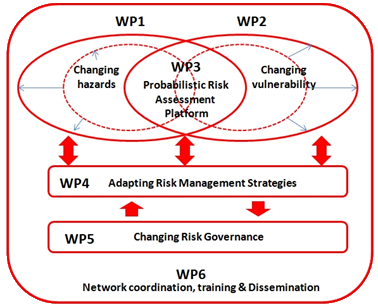
The overall strategy of the network is to bring together a group of researchers with diverse backgrounds, and disciplines. These experts together will make distinct and important contributions to solving problems in analyzing the effect of environmental changes on the risk for hydro-meteorological hazards and management.
Workpackages
The project has the following Work packages:
Research objectives
- Analysis of the changes in the frequency, magnitude and extend of hydro-meteorological hazards, as a result of environmental changes. These are analyzed both as single hazards, but also in a multi-hazard context, looking specifically at the interaction of the hazards. The results of this analysis are stochastic scenarios of possible triggering events, based on a combination of historical information, identification of mechanisms, downscaling of climate change models and use of predicted storm tracks, together with the resulting scenarios of hazard magnitude, extend and frequency.
- Analysis of the changes in exposed elements at risk and their vulnerabilities. This starts with an inventory of exposed elements at risk, and their characterization in terms of aspects that can be used for the assessment of vulnerability. The uncertainty in the expression of vulnerability is an important component. These uncertainties become large when dealing with the evaluation of future changes in exposed elements at risk, based on several land use scenarios.
- Probabilistic hazard scenarios are combined with scenarios of exposure data and their vulnerabilities to assess the risk in a probabilistic manner. Given the large uncertainties involved in predicting changes in risk, a probabilistic scenario is the most feasible one. A flexible modeling platform for multi hazard assessment at different scales will be developed. Dependent on the scale and requirements for risk management the modeling platform will use various statistical or physically-based models. It is able to link hazard processes, which are controlled by certain thresholds to forecast domino effects. Research is focused on the performance of these models in relation to data requirements and their effectiveness for multi risk assessment at different scales. The modeling platform will be user-friendly and is aimed to be used by stakeholders/end-users dealing with hazard and risk management.
- Hazard, vulnerability and risk assessment models will be combined into a web-based platform based on Open Source software which allows for a harmonisation/standardization of methods applicable in priority areas.
- These risk scenarios form the starting point for defining risk management strategies that will concentrate on spatial planning and emergency preparedness. The risk reduction measures are implemented in a Decision Support System (DSS) which is also integrated in the platform.